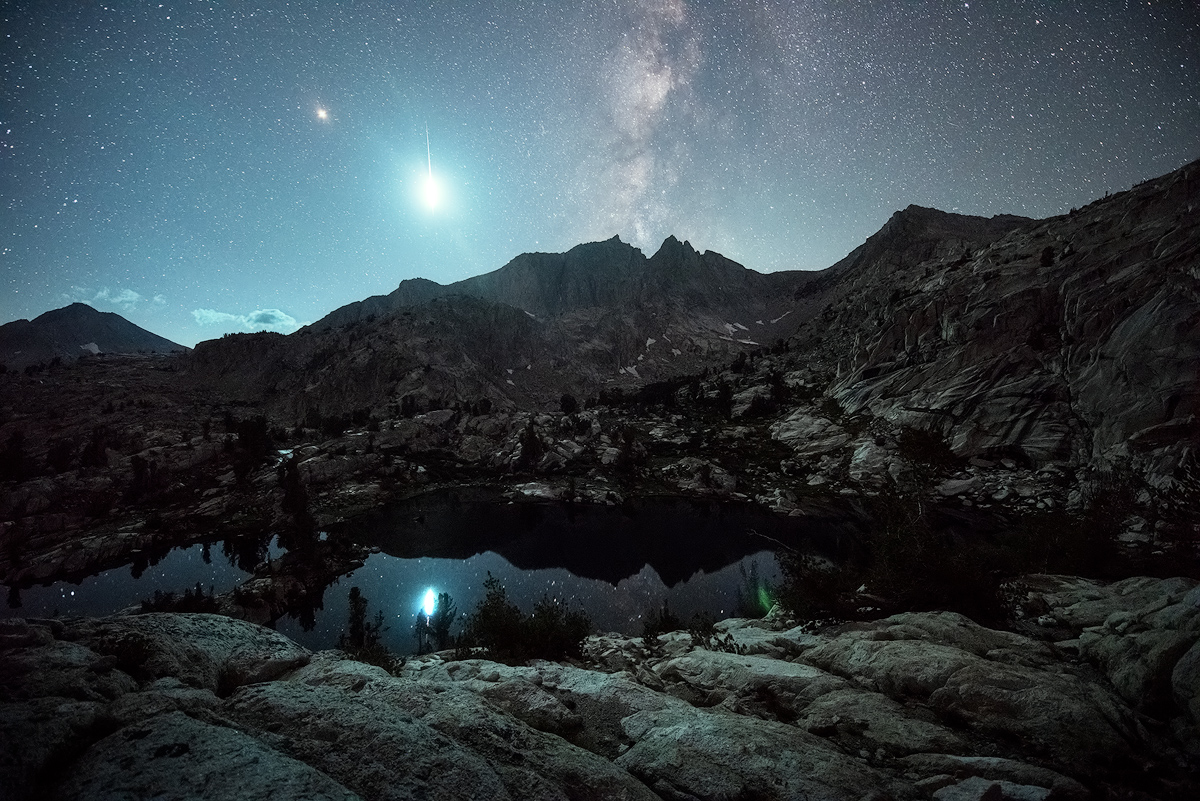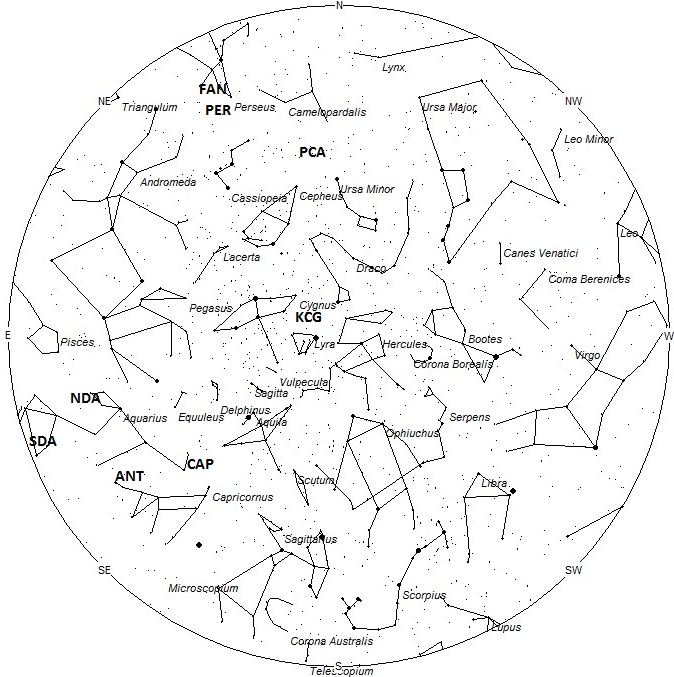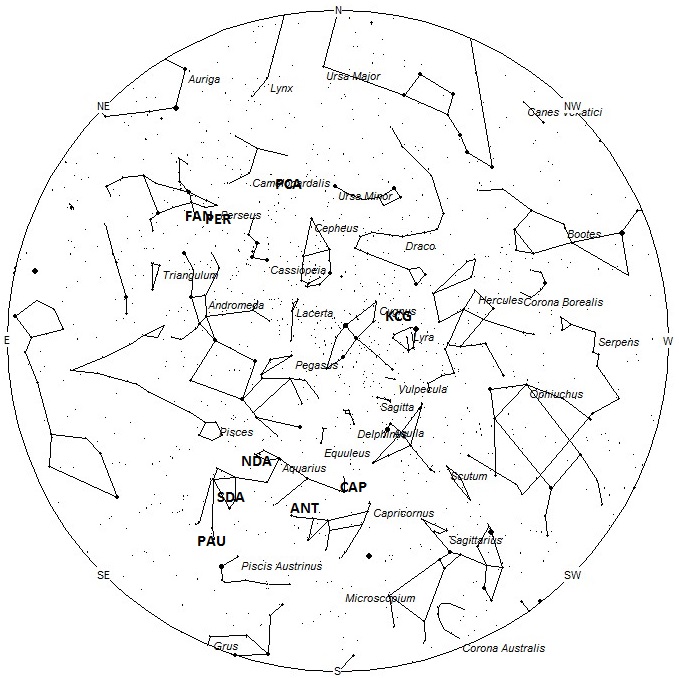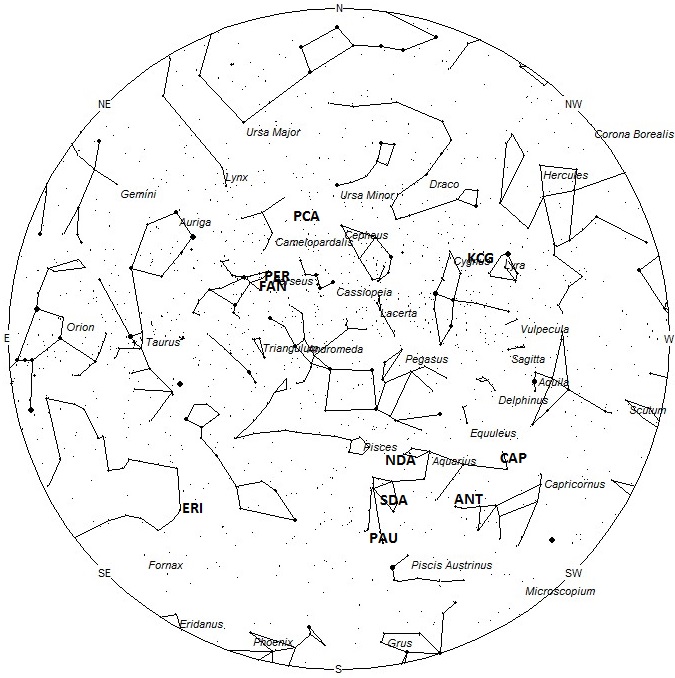 This brilliant alpha Capricornid fireball was captured by Brad Goldpaint from near Indepencence, CA, USA on 21 July 2018 at 09:21 Universal Time. © Brad Goldpaint https://goldpaintphotography.com/
This brilliant alpha Capricornid fireball was captured by Brad Goldpaint from near Indepencence, CA, USA on 21 July 2018 at 09:21 Universal Time. © Brad Goldpaint https://goldpaintphotography.com/Meteor activity kicks into high gear in August as seen from the northern hemisphere. The main reason for all this activity is the Perseid shower that peaks on August 13th. This shower is active most of the month and remains above the level of the sporadic background for a week centered on August 13th. The sporadic activity is also near maximum as seen from the northern hemisphere and is now more than double the rates from just three months ago. As seen from southern hemisphere, meteor rates are still decent but falling rapidly. The sporadic rates continue their downward slide and the Perseid radiant does not rise high into the sky as seen in the southern hemisphere. So rates for the Perseids are greatly reduced when compared to those seen from the northern hemisphere.
During this period the moon will reach its last quarter phase on Saturday August 4th. This is good for evening observations but once the moon rises during the early morning hours, conditions will be less than ideal. These conditions improve with each passing night to where there is little lunar interference at the end of this period. The estimated total hourly meteor rates for evening observers this week is near 4 as seen from mid-northern latitudes and also 3 for those viewing from subtropical southern latitudes (25S). For morning observers the estimated total hourly rates should be near 20 for those viewing from mid-northern latitudes and also 18 for those viewing from subtropical southern latitudes (25S). The actual rates will also depend on factors such as personal light and motion perception, local weather conditions, alertness and experience in watching meteor activity. Rates are reduced during the morning hours due to moonlight. Note that the hourly rates listed below are estimates as viewed from dark sky sites away from urban light sources. Observers viewing from urban areas will see less activity as only the brighter meteors will be visible from such locations.
The radiant (the area of the sky where meteors appear to shoot from) positions and rates listed below are exact for Saturday night/Sunday morning August 4/5. These positions do not change greatly day to day so the listed coordinates may be used during this entire period. Most star atlases (available at science stores and planetariums) will provide maps with grid lines of the celestial coordinates so that you may find out exactly where these positions are located in the sky. A planisphere or computer planetarium program is also useful in showing the sky at any time of night on any date of the year. Activity from each radiant is best seen when it is positioned highest in the sky, either due north or south along the meridian, depending on your latitude. It must be remembered that meteor activity is rarely seen at the radiant position. Rather they shoot outwards from the radiant so it is best to center your field of view so that the radiant lies near the edge and not the center. Viewing there will allow you to easily trace the path of each meteor back to the radiant (if it is a shower member) or in another direction if it is a sporadic. Meteor activity is not seen from radiants that are located far below the horizon. The positions below are listed in a west to east manner in order of right ascension (celestial longitude). The positions listed first are located further west therefore are accessible earlier in the night while those listed further down the list rise later in the night.
These sources of meteoric activity are expected to be active this week.
The first of the kappa Cygnids (KCG) should appear late next week from a radiant located near 18:40 (280) +45. This area of the sky lies in northern Lyra, 6 degrees northeast of the brilliant zero magnitude star known as Vega (alpha Lyrae). This radiant is best laced near 2300 Local Summer Time, when it lies on the meridian and is located highest in the sky. With an entry velocity of 21 km/sec., the average meteor from this source would be of slow velocity.
The alpha Capricornids (CAP) are active from July 3 through August 11 with maximum activity occurring during the last week of July. The broad maximum occurs anywhere from July 25 to the 30th with visual rates usually around 3 per hour. The radiant is currently located at 20:42 (310) -08, which places it in western Aquarius, 2 degrees northwest of the 4th magnitude star known as Albali (epsilon Aquarii). This radiant is best placed near 0100 LST, when it lies on the meridian and is located highest in the sky. With an entry velocity of 22 km/sec., the average alpha Cap meteor would be of slow velocity.
The center of the large Anthelion (ANT) radiant is currently located at 21:40 (325) -14. This position lies in northeastern Capricornus, 2 degrees northwest of the 3rd magnitude star known as Deneb Algedi (delta Capricorni). Due to the large size of this radiant, Anthelion activity may also appear from western Aquarius as well as Capricornus. This radiant is best placed near 0200 LST, when it lies on the meridian and is located highest in the sky. Hourly rates at this time should be near 2 as seen from mid-northern latitudes and 3 as seen from tropical southern latitudes. With an entry velocity of 30 km/sec., the average Anthelion meteor would be of medium-slow velocity.
The Northern delta Aquariids (NDA) are active from July 23 through August 27. The radiant is currently located at 22:36 (339) -01. This position is located in northern Aquarius, 1 degree south of the 4th magnitude star known as eta Aquarii. Maximum activity is not expected until August 14, so hourly rates will low at this time. The radiant is best placed near 0300 LST, when it lies highest in the sky. With an entry velocity of 38 km/sec., these meteors would be of medium velocities. This shower seems to be a continuation of the Northern June Aquilids, which had been active since early June.
The Southern Delta Aquariids (SDA) are active from a radiant located at 23:04 (346) -14. This position is located in central Aquarius, 3 degrees northeast of the 3rd magnitude star known as Skat (delta Aquarii). Hourly rates are still decent with observers in the northern hemisphere seeing 2-5 per hour and those south of the equator seeing 5-10 per hour. The radiant is best placed near 0300 LST, when it lies highest in the sky. With an entry velocity of 41 km/sec., most activity from this radiant would be of average velocities.
The Piscids Austrinids (PAU) are an obscure shower, not well seen from the northern hemisphere. Recent studies by the IMO Video Network shows no activity at all. Other studies have indicated that this shower is active later than previously thought. We will go along with that idea until more information is available. It is now thought that this radiant is active from July 30 through August 18, with maximum activity occurring on the 8th. Using these parameters, the current position of the radiant would be 23:18 (350) -22. This area of the sky is located in southern Aquarius, 8 degrees northeast of the bright 1st magnitude star known as Fomalhaut (alpha Piscis Austrini). The radiant is best placed near 0300 LST, when it lies highest in the sky. Current rates would most likely be less than 1 per hour, no matter your location. With an entry velocity of 44km/sec., most activity from this radiant would be of average velocities.
The Perseids (PER) are active from a radiant located at 02:26 (037) +56. This position lies in extreme northwestern Perseus, 4 degrees west of the 4th magnitude star known as Miram (eta Persei). This area of the sky is best placed for viewing during the last dark hour before dawn when it lies highest in the sky. Maximum is not until August 13 so current rates are expected to be near 5 per hour as seen from the northern hemisphere and 2 as seen from south of the equator. Unfortunately these meteors are not well seen from the southern hemisphere. With an entry velocity of 59 km/sec., the average meteor from this source would be of swift velocity.
The eta Eridanids (ERI) were discovered by Japanese observers back in 2001. Activity from this stream is seen from July 23 though September 17 with maximum activity occurring on August 11. The radiant currently lies at 02:36 (039) -14, which places it in eastern Cetus, 2 degrees west of the 4th magnitude star known as pi Ceti. This area of the sky is best seen during the last dark hour before dawn when the radiant lies highest in a dark sky. Current rates are expected to be less than 1 per hour as seen from the northern hemisphere and near 1 per hour as seen from south of the equator. With an entry velocity of 65 km/sec., the average meteor from this source would be of swift velocity.
The 49 Andromedids (FAN) were discovered by Željko Andreić et al of the Croatian Meteor Network, using databases from SonotaCo, 2013 and CMN, 2013). These meteors are active from July 6 through August 14 with maximum activity occurring on July 21. The current position of the radiant is 02:46 (041) +54. This position lies in extreme northwestern Perseus, only 1 degree west of the 4th magnitude star known as tau Persei. This location is very close to the Perseid radiant and care must be taken to distinguish between these two sources. The Perseids are expected to be far more numerous during this period. This area of the sky is best placed for viewing during the last dark hour before dawn when it lies highest in the sky. Rates are currently expected to be less than 1 per hour no matter your location. With an entry velocity of 60 km/sec., the average 49 Andromedid meteor would be of swift velocity.
The last of the psi Cassiopeiids (PCA) are expected this week. These meteors are active from July 5 through August 7 with maximum activity occurring on July 22. The current position of the radiant is 03:54 (059) +78. This position lies in a remote are of northwestern Camelopardalis, 8 degrees northeast of the faint star known as 50 Cassiopeiae. This area of the sky is best placed for viewing during the last dark hour before dawn when it lies highest in the sky. Rates are currently expected to be less than 1 per hour no matter your location. With an entry velocity of 42 km/sec., the average psi Cassiopeiid meteor would be of medium speed.
As seen from the mid-northern hemisphere (45N) one would expect to see approximately 10 sporadic meteors per hour during the last hour before dawn as seen from rural observing sites. Evening rates would be near 3 per hour. As seen from the tropical southern latitudes (25S), morning rates would be near 7 per hour as seen from rural observing sites and 2 per hour during the evening hours. Morning rates are reduced during this period due to moonlight. Locations between these two extremes would see activity between the listed figures.
The list below offers the information from above in tabular form. Rates and positions are exact for Saturday night/Sunday morning except where noted in the shower descriptions.
| SHOWER | DATE OF MAXIMUM ACTIVITY | CELESTIAL POSITION | ENTRY VELOCITY | CULMINATION | HOURLY RATE | CLASS |
| RA (RA in Deg.) DEC | Km/Sec | Local Summer Time | North-South | |||
| kappa Cygnids (KCG) | Aug 13 | 18:40 (280) +45 | 21 | 23:00 | <1 – <1 | II |
| alpha Capricornids (CAP) | Jul 27 | 20:42 (310) -08 | 22 | 01:00 | 2 -2 | II |
| Anthelions (ANT) | – | 21:40 (325) -14 | 30 | 02:00 | 1 – 2 | III |
| Northern delta Aquariids (NDA) | Aug 14 | 22:36 (339) -01 | 38 | 03:00 | <1 – <1 | IV |
| Southern delta Aquariids (SDA) | Jul 30 | 23:04 (346) -14 | 41 | 04:00 | 2 – 3 | I |
| Piscids Austrinids (PAU) | Aug 08 | 23:18 (350) -22 | 44 | 04:00 | <1 – 1 | IV |
| Perseids (PER) | Aug 13 | 02:26 (037) +56 | 59 | 06:00 | 5 – 2 | I |
| eta Eridanids (ERI) | Aug 11 | 02:36 (039) -14 | 65 | 06:00 | 1 – 1 | IV |
| 49 Andromedids (FAN) | Jul 21 | 02:46 (041) +54 | 60 | 06:00 | <1 – <1 | IV |
| psi Cassiopeiids (PCA) | Jul 22 | 03:54 (059) +78 | 42 | 07:00 | <1 – <1 | IV |







 You saw something bright and fast? Like a huge shooting star? Report it: it may be a fireball.
You saw something bright and fast? Like a huge shooting star? Report it: it may be a fireball.  You counted meteors last night? Share your results with us!
You counted meteors last night? Share your results with us!  You took a photo of a meteor or fireball? You have a screenshot of your cam? Share it with us!
You took a photo of a meteor or fireball? You have a screenshot of your cam? Share it with us!  You caught a meteor or fireball on video? Share your video with us!
You caught a meteor or fireball on video? Share your video with us!